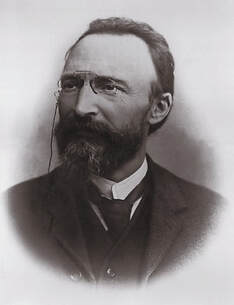 Blessed Bartolo Longo (1841-1926) was beatified by St. John Paul II on 26th October 1980. Pope Benedict XVI, speaking of Bartolo Longo in a homily, likened him to St Paul of Tarsus, who also initially persecuted the Church and described Bartolo as being "militantly anticlerical and engaging in spiritualist and superstitious practices". His story is quite amazing. Born into a devoutly Catholic family in the small town of Latiano in Brindisi, southern Italy, Bartolo grew up in a home where his parents, Bartolomeo and Antonina prayed the rosary together daily. However when Bartolo was just 10 years old, his mother died and he slowly drifted away from the faith. Studying Law at university in Naples he became involved with an occult sect and was “ordained” as a satanic “priest”. He took part in séances, fortune telling and orgies and began to publicly ridicule Christianity encouraging other Catholics to leave the Church. None of these activities brought him any joy and his personal life was marked by extreme depression, paranoia, confusion and anxiety. He ultimately experienced a complete mental breakdown. In the depths of despair, Bartolo heard the voice of his deceased father urging him to “return to God, return to God”. He turned to a friend for help, who convinced him to abandon Satan and seek the help of a Dominican priest, Fr Alberto Radente. Bartolo made a full confession and Fr Radente further helped him to reclaim his life.
One evening, as he walked near-the ruins of a chapel in Pompeii, Bartolo had a profound mystical experience. He wrote: "As I pondered over my condition, I experienced a deep sense of despair and almost committed suicide. Then I heard an echo in my ear of the voice of Friar Alberto repeating the words of the Blessed Virgin Mary: ‘If you seek salvation, promulgate the rosary. This is Mary's own promise’. These words illumined my soul. I went on my knees. 'If it is true. I will not leave this valley until I have propagated your rosary.' Bartolo became a Third Order Dominican, taking the name Brother Rosario in honour of the rosary and joined a charitable group in Pompeii. He worked alongside Countess Mariana di Fusco, a wealthy local widow whom he later married.The couple decided to start a confraternity of the rosary. To serve as a spiritual focus for this group, Bartolo needed a painting of the Blessed Virgin and was offered one by Sister Maria Concetta de Litala of the Monastery of the Rosary at Porta Medina. She had found it in a second hand shop in Naples and had paid a tiny amount of money for it. Though it was not considered of particular aesthetic beauty and was in very poor condition, it served Bartolo's purpose. He described it in his journal: "Not only was it worm-eaten, but the face of the Madonna was that of a coarse, rough country-woman, a piece of canvas was missing just above her head, her mantle was cracked. Nothing need be said of the hideousness of the other figures. St Dominic looked like a street idiot. To Our Lady's left was a St Rose. This I had changed later into a St Catherine of Siena . I hesitated whether to refuse the gift or to accept, I took it."
In addition, Bartolo restored a ruined church in Pompeii in October 1873 and then sponsored a feast in honour of Our Lady of the rosary. He installed the repaired painting in this very church. Within hours of its installation miracles began to be reported and people came to the church in droves. Seeing the devotion of the pilgrims, the Bishop of Nola encouraged Bartolo to construct a larger church. He approached the architect Giovanni Rispoli to build it, making the following appeal: "In this place selected for its prodigies, we wish to leave to present and future generations a monument to the Queen of Victories that will be less unworthy of her greatness but more worthy of our faith and love." Bartolo continued promoting the rosary and spreading devotion to Our Lady until his death in 1926, at the age of 75. He would evangelise young people at parties and in local cafes, explaining the dangers of occultism. He would witness continually as to the glories of Christ, the munificence of His mother and the beauty of the Catholic Faith.
0 Comments
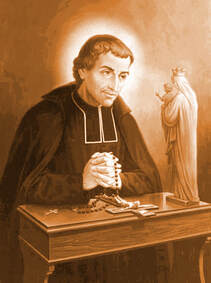 St Louis Marie was born in Brittany in 1673. He studied in Paris and was ordained to the priesthood in 1700. He died at the age of 43 years in St Laurent sur Sevres, after a life as an itinerant preacher, devoted to the poor and to preaching against the errors of Jansenism, which did not make him popular with some of the bishops of his time. Pope Clement XI conferred on him the title and authority of Missionary Apostolic, confirming him in his mission . As a student, he took great delight in researching the writings of the Church Fathers, Doctors and Saints as they related to the Blessed Virgin Mary, to whom he was singularly devoted. Under her inspiration, he founded the Daughters of Divine Wisdom, who were committed to the care of the destitute and in 1715, a year before his death, founded a missionary band known as the Company or Mary. A member of the Third Order of St Dominic, he was one of the greatest apostles of the Rosary in his day, promoting authentic Marian devotion wherever he went. His greatest contribution to the Church and the world is Total Consecration to the Blessed Virgin. Among his most influential writings were: The Secret of Mary, The Secret of the Rosary, True Devotion to Mary which has influenced countless people since, including Pope John Paul II, Frank Duff, founder of the Legion of Mary and Matt Talbot, to name but a few. The cause for his declaration as a Doctor of the Church is now being pursued. Although St Louis is perhaps best known for his Mariology and devotion to the Blessed Virgin Mary, his spirituality is founded on the mystery of the Incarnation of Jesus Christ, and is centred on Christ. Hail, then, O immaculate Mary,
living tabernacle of the Divinity, where the Eternal Wisdom willed to be hidden and to be adored by angels and by men! Hail, O Queen of Heaven and earth, to whose empire everything is subject which is under God. Hail, O sure refuge of sinners, whose mercy fails no one. Hear the desires which I have of the Divine Wisdom; and for that end receive the vows and offerings which in my lowliness I present to thee. St Louis Marie, from “True Devotion to the Blessed Virgin Mary” all the light we cannot see, by Anthony Doerr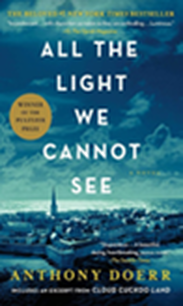 The title caught my attention. “All the Light we cannot see” immediately set me thinking of the mystery of God. I knew that the drama series was not going to explicitly approach the mystery of God. Nevertheless, I wondered if anything of what the title evoked for me was to be found in the programme. I decided to take a look. I wasn’t disappointed. This is a short, four-part drama series, recently released in November 2023 currently streaming on Netflix which is based on the The Puliter Prize winning novel of the same name by Anthony Doerr (2014). The story unfolds in the context of World War II, mainly in Occupied France. The two characters we follow most closely are Marie-Laure LeBlanc who is a young French teenager who is blind, and Werner Pfenning who is a German youth serving in Hitler’s Nazi army. Their paths finally cross in the French port of St Malo, at the end of the War. We won’t spoil it for you by saying too much! However, some reflections that might accompany your viewing, concern how Truth and beauty are attributes of God and following on from this the whole of creation is marked by truth and beauty, points to God and communicates something of God. The human spirit is consoled, strengthened and ennobled by truth and can better withstand the onslaught of evil and destruction when it has been formed and tasted truth. Worth watching! We often use language associated with light in order to say something about God. Making a connection between God and light in this way has of course a firm basis in Scripture. The Book of Genesis tells the story of creation and how God created all that is, created light, separated light from darkness, modulated the rhythms of day with night, and the unfolding of seasons. In the New Testament the theme of light is especially developed in the Gospel of St John - which notably "God is light, in him there is no darkness at all". Jesus is "The Light of the World", those who follow Him "walk in the light" (cf. also Is.). Mystics and theologians throughout the centuries have endeavoured to speak of God and have taken up the language of light. God is so knowable, infinitely knowable – no matter how close we come to God, how much we know Him, we could never as it were exhaust the mystery of God. Trish 1/2/2024 book review - conscience before conformity: Hans and Sophie Scholl and The White Rose resistance in Nazi Germany, by paul shrimptonRead NowConscience before Conformity: Hans and Sophie Scholl and The White Rose resistance in Nazi Germany, by Paul Shrimpton (Gracewing).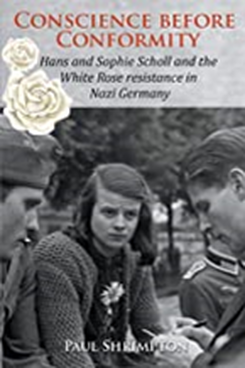 In the midst of Nazi oppression a few young German students had the freedom of thought and courage to speak the truth. They took the name of The White Rose - and with the limited means available to them, especially through printed leaflets, they opposed Hitler and the Third Reich and called on others to offer peaceful determined resistance to the spread of Nazism. Hans and Sophie Scholl along with Christoph Probst were tried and executed by the Nazis in Munich in1943. The story of Hans and Sophie Scholl who were the inspiration and leaders of The White Rose movement has been told many times. However, prior to this book by Paul Shrimpton it seems that a critical aspect had been ignored. No-one had spoken about the reality that Christian faith undergirded and fuelled their daring endeavour: the students and most of those who influenced them were Christians and in particular Catholic. Here at last Shrimpton rectifies this omission. We are introduced to their journey: how they discovered and drank deeply from the thought of great Christian writers such as St Augustine, St Thomas Aquinas, Pascal and St John Henry Newman. These young people changed radically: from being actively involved in the Hitler Youth they stepped out, took up the countercultural dangerous path of resistance to Nazism. Newman and his ‘theology of conscience’ had a remarkable effect on the students and on Sophie in particular. Her conscience was awoken, she regained her freedom and the necessary assurance and courage to resist the draw of evil and live. The White Rose printed leaflets with which they set forth their ideas and denounced Nazism. We might wonder at the power of words: how reading Newman opened a new path for these young people; how the Nazis searched out and tried to silence the authors of these pamphlets. We can learn from the story of The White Rose, draw inspiration from them in our times when we too must choose between conscience and conformity. Then and now, their words speak out and bring hope. Certainly this book is worth reading. Trish A DEFINITION OF 'PARABLE'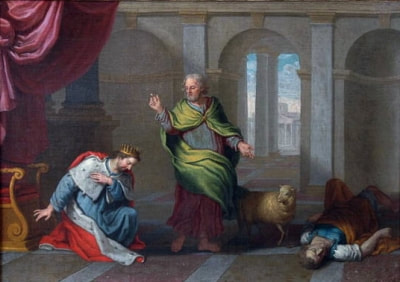 Nathan Reproaches David, Englebert Fisen (1655 - 1733) Nathan Reproaches David, Englebert Fisen (1655 - 1733) The Greek root of the term translated into English as ‘parable’ παραβολή is found in ‘παρα’ meaning ‘close beside’ or ‘with’ and the verb ‘βάλλω’ ‘I cast’. It means a juxtaposition or comparison and appears already in the 4th century BC writings of Plato[1] and Aristotle[2]. In the New Testament, parable is considered to be a teaching aid, cast alongside the truth being taught for the sake of comparison. Much has been made of the Greek cultural influence on the Gospel writers, sometimes at the expense of the Semitic influence. In the Septuagint, παραβολή is also used to translate the Hebrew term מָשָׁל transliterated as ‘mashal’. The noun has a more wide-ranging meaning than we would typically associate with the word ‘parable’ as we understand it in English and is used around forty times in the Old Testament, having been translated as ‘argument’ (Job 27:1; 29:1), ‘oracle’ (Nb 23:7, 18; Hab: 2:6), ‘byword’, ‘discourse’, ‘parable’ (Ezek 17:2) ‘proverb’ (1 Sam 10:12) ‘taunt’ (Is 14:4). However, when examined, it appears to represent a much broader category of literary devices, including: simile, fable, riddle, allegory, symbol, example and theme. The parable can be a simile developed and expanded into a story. The Hebrew also has a verbal form משׁל, which means to ‘represent’ or ‘be like’. The verb denominative can mean to ‘use a proverb’, ‘speak in parables or sentences of poetry’. The latter is most common in the prophet Ezekiel (12:23; 17:2; 24:3; 17:3 for example). The uses of מָשָׁל will be considered in the next section. This accounts for how, when used in the New Testament ‘parable’ is at times a very loose and general term, as the use of it in Lk 6:39-42 demonstrates. The parables of Jesus share some common traits: the story is made up of basic components that are true to life, although the story itself may be fictitious. The similes used are commonly agricultural regarding seeds and sowing for example or concerned with fishing, but also coins, leaven, lamps are frequently mentioned. An overall message is generally communicated through the story, with any extra details at the service of the main message. PARABLES IN THE OLD TESTAMENT It was while researching the whole area of parables in the Bible in preparation for a dissertation on The Good Samaritan, that I came across the notion of ‘parable’ in the Old Testament. The Old Testament is brimming with metaphorical language and unforgettable imagery. The Jews had many apothegms and perceptive witty sayings, not to mention the Wisdom writings and in particular the Book of Proverbs. Some of the parables told by Jesus can be recognised in familiar Old Testament ones with the new reality of the Kingdom of God set in their heart. The parable of the Wicked Husbandmen, recounted by all three synoptic gospels (Mt 21: 33-46; Mk 12: 1-12; Lk 20:9-19), finds an Old Testament echo in Isaiah 5:1-7, as does the parable of the Mustard Seed (Mt 13:31-32; Mk 4:30-32; Lk 13:18-19) in Ezekiel 17:1-24. But perhaps those stories in the Old Testament that conform most closely to the New Testament version of ‘parable’ as illustrated in the Good Samaritan, even though they are sometimes not actually associated with the word מָשָׁל mashal, are the narratives of the Poor Man’s Ewe Lamb (2 S 12:1-4), the Tekoan Woman (2 S 14:4), the Lost Prisoner (1 K 20:38-42), the Vineyard (Is 5:1-7) and the Ploughman (Is 28:23-29). The Old Testament parables were frequently a tool in the hands of the Prophets, serving as a reminder of God’s Covenant and the Law and they provide some indications of both the moral and social aspects of life in the history and journey of God’s people. The Poor Man’s Ewe Lamb, in 2 Samuel (12:1-4), which continues to have its place in the Lectionary[3], demonstrates very clearly the power of parabolic speech. However, not all scholars agreed about its classification as a ‘parable’. Hermann Gunkel, the influential German Old Testament scholar and founder of form criticism, argued that “it affords no parallel at all to the situation to which it is applied” and consigned it to the stock of ‘fairy tales’ as it did not seem to belong to the context.[4] The parable itself is made up of only four verses and is spoken by the prophet Nathan. It is concise and to the point and stirs up in any heart a sense of anger at the injustice served by the rich man and a deep sense of sympathy and compassion for the poor man, whose cherished and only ewe lamb is seized needlessly by the rich man to furnish his table upon the arrival of a ‘stranger’. It is an extraordinary accomplishment in such a few words and the effect it had on David, who recognised in it the utterly despicable nature of his adultery and murderous crime, was just as striking. The story exemplifies the notion of juxtaposition or casting something alongside the truth being taught for the sake of comparison, that we have come to recognise as ‘parable’. It is the Lord who communicates in this way with David through the intermediary of the prophet Nathan because “the thing that David had done displeased the Lord” (2 S 11:27). By a careful selection of words, Nathan, who has the very difficult task of communicating God’s displeasure to David, leads the king to unsuspectingly pronounce judgment on his own deeds. “You are the man”, Nathan reveals the truth to David (2 S 12:7). In a similar way, the parable of the wicked tenants (husbandmen) (Mt 21:33-45) causes Jesus’ hearers to pronounce judgement on themselves without being aware of it, through the insertion of λέγουσιν αὐτῷ in Mt 21:41. This is also the case in the parable of the Two Sons (Mt 21:31) and in the Sinful Woman forgiven (Lk 7:43).[5] The parable has been described in different ways: Simon categorises it as a ’juridical parable’ in that it “constitutes a realistic story about a violation of the law, related to someone who had committed a similar offence with the purpose of leading the unsuspecting hearer to pass judgment on himself”.[6] For MacDougall, it is a ‘parable of fact’ as opposed to one of ‘fable’ or ‘fancy’[7] although Von Rad regarded it as a ‘fable’ of which many are applied in a political context. “In the fable, there occurs a veiling of something everyday, a kind of alienation in the direction of the unreal and the fabulous. But precisely in this strange dress the truth is more forceful than in the everyday where it is so easily overlooked”[8] In MacDougall’s estimation, the Old Testament parables provided the “scheme, the system, the power and the genius of parabolic teaching.”[9] [1] BURNET, J., Platonis opera, vol. 2. ΣΩ. Ἐρρήθη γάρ που τότε ἐν τῇ παραβολῇ τῶν βίων μηδὲν δεῖν μήτε μέγα μήτε σμικρὸν χαίρειν τῷ τὸν τοῦ νοεῖν καὶ φρονεῖν βίον ἑλομένῳ. soc. Yes, for it was said, you know, in our comparison of the lives that he who chose the life of mind and wisdom was to have no feeling of pleasure, great or small. [2] ROSS, W.D. Aristotelis ars rhetorica [3] The parable of the Poor Man’s Ewe lamb continues to form a part of the Catholic Lectionary and is read on Saturday of Week 3 of Ordinary Time (Cycle II) including David’s penitence (2 S 12:1-7, 10-17). The gospel reading is Mk 4:35-41, the calming of the storm. The psalm is 50: A pure heart create for me O God. [4] SIMON, Uriel. “The Poor Man’s Ewe-Lamb, An Example of a Juridical Parable” p.220 [5] Cf. JEREMIAS, J. The Parables of Jesus, p.28 [6] SIMON, Uriel. “The Poor Man’s Ewe-Lamb, An Example of a Juridical Parable”, pp. 220-221 [7] MacDOUGALL, John. The Old Testament Parables, pp. 9-10. [8] VON RAD, G. Wisdom in Israel, p.42 [9] MacDOUGALL, John. The Old Testament Parables, pp. 9-10. REFERENCES
BURNET, J. Platonis opera, vol. 2, Oxford: Clarendon Press, 1901 (repr. 1967): St II.11a-67b. [Online: http://stephanus.tlg.uci.edu/Iris/Cite?0059:010:55521] JEREMIAS, Joachim. The Parables of Jesus, (3rd Revised Edition). London: SCM Press Ltd, 1972 Translation based on that of: S.H. Hooke from German Die Gleichnisse Jesu, 6th edition published 1962 by Vandenhoeck & Ruprecht, Gottingen. Revised Edition. Chatham: W. & M. Mackay & Co. Ltd, 1963. MACDOUGALL, John. The Old Testament Parables. London: James Clarke and Company, 1934. ROSS, W.D. Aristotelis ars rhetorica, Oxford: Clarendon Press, 1959 (repr. 1964): 1-191 (1354a1-1420a8). [Online: http://stephanus.tlg.uci.edu/Iris/Cite?0086:038:326191] SIMON, Uriel. “The Poor Man’s Ewe-Lamb, An Example of a Juridical Parable” Biblica, 1967, Vol 48, No. 2 pp.207-242. [Online https://www.jstor.org/stable/pdf/23488221.pdf?ab_segments=0%2Fbasic_search_gSIMON, Uriel. VON RAD, Gerhard. Wisdom in Israel. First published in German under title Weisheit in Israel, Neukirchen-Vluyn, 1970. English translation James D. Martin. London: SCM Press Ltd., 1993. |
Details
Archives |
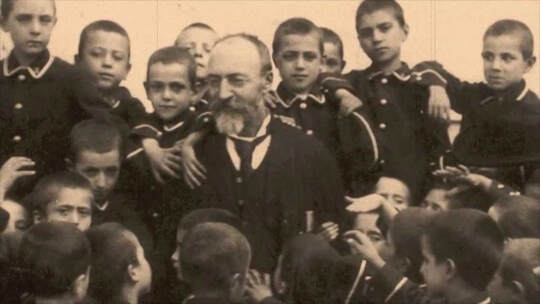
 RSS Feed
RSS Feed